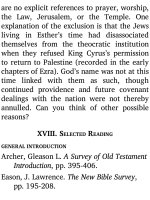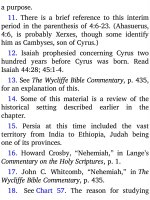Jensens survey of the old testament adam 129
Bạn đang xem bản rút gọn của tài liệu. Xem và tải ngay bản đầy đủ của tài liệu tại đây (321.43 KB, 4 trang )
are in a new and bright era of Israel’s history
—the period of restoration, involving a
return from captivity to the homeland of
Canaan. Fix in your mind the following
simple outline of the context of Ezra and
Nehemiah as you prepare to survey the
books.
There would have been no restoration for
Israel were it not for the grace of God. The
restoration was surely not deserved. And
before there was even a captivity, the
restoration was scheduled on a prophetic
timetable by a gracious God who, in the
forthcoming captivity period, would be
calling out of the communities of Jewish
exiles in Babylon a remnant of believers
whom He could bring back to the promised
land. With these He would perpetuate His
covenanted blessings for the generations to
come.
3. Read Jeremiah’s earlier prophecies
about captivity and return in Jeremiah
25:11-14 and 29:10-14.
4. Spend time acquainting yourself with
the following historical antecedents of these
books. Some of this material will be review
of things studied earlier.
a) The Two Captivities
The word “restoration,” as applied to
Ezra’s day, refers to the return of God’s
people to Canaan from captivity. That
captivity took place in two stages, which are
known as the Assyrian and Babylonian
captivities. See Chart 56.
1) Assyrian Captivity (fall of Samaria, 722
B.C., recorded in 2 Kings 17)
Most of the people and rulers of the ten
tribes of the Northern Kingdom of Israel
were deported to Assyria and scattered
among the inhabitants there. (Locate Assyria
o n Map O. ) The Zondervan Pictorial Bible









